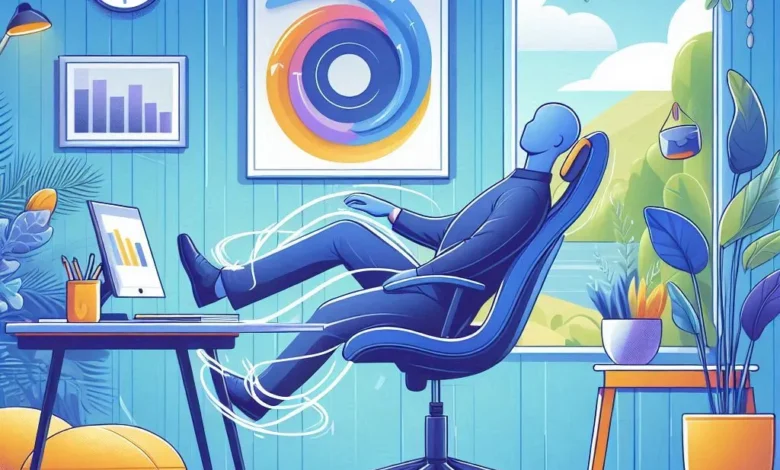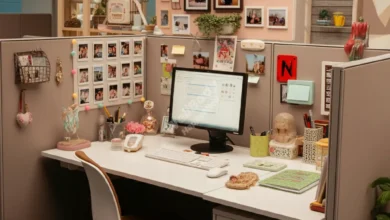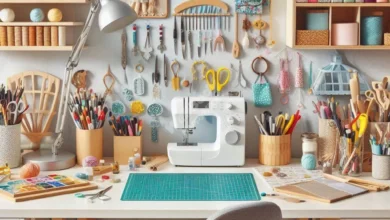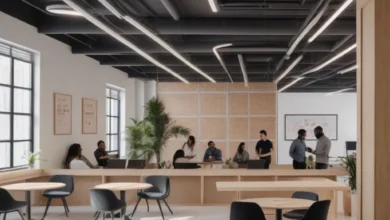Kinetic Workspaces: Active Solutions for Desk Jobs

Are you tired of feeling stiff and sluggish after a long day at your desk? It’s time to discover the world of kinetic workspaces! These innovative setups are designed to keep you moving, even when you’re seated. In this article, we’ll explore how to create an active office environment that boosts your health and productivity.
Let’s face it: many of us spend hours glued to our chairs. But our bodies aren’t built for this sedentary lifestyle. Sitting for long periods can lead to a host of health issues, including:
- Back pain
- Poor posture
- Increased risk of heart disease
- Weight gain
The good news? You don’t need to quit your desk job to stay healthy. By incorporating movement at work, you can counteract these risks and feel better throughout your day.
The Science Behind Movement at Work
Physical Health Benefits
Regular movement isn’t just good for your muscles and joints. It’s crucial for your overall health. When you move, even in small ways, you:
- Boost circulation
- Improve posture
- Reduce the risk of chronic diseases
- Maintain a healthy weight
Cognitive Perks
Your brain loves movement too! Studies show that staying active at work can:
- Enhance focus and concentration
- Boost creativity
- Improve problem-solving skills
- Reduce stress and anxiety
Research Highlights
Here’s what the science says about the benefits of movement in the workplace:
- A study in the Journal of Physical Activity and Health found that standing desks can burn up to 87 more calories per day compared to sitting.
- Research published in the International Journal of Behavioral Nutrition and Physical Activity showed that active workstations can improve mood and reduce fatigue.
- A review in the Annals of Internal Medicine linked prolonged sitting to a higher risk of heart disease, diabetes, and cancer.
By creating a kinetic workspace, you’re not just following a trend. You’re making a science-backed decision to improve your health and well-being.
Creating a Kinetic Workspace: Essential Elements
Transforming your office into a kinetic workspace doesn’t have to be complicated. Let’s explore some key components that can help you stay active throughout your workday.
Active Seating Options
Say goodbye to your standard office chair! Active seating encourages subtle movements that engage your core and improve posture. Here are some popular options:
- Balance Ball Chairs: These chairs replace the seat with an exercise ball, promoting constant micro-movements.
- Wobble Stools: With a rounded base, these stools allow for a range of motion while seated.
- Kneeling Chairs: These chairs distribute your weight between your bottom and shins, encouraging an upright posture.
Here’s a quick comparison of these active seating options:
| Seating Type | Pros | Cons |
|---|---|---|
| Balance Ball Chair | Engages core muscles, improves posture | May be uncomfortable for long periods |
| Wobble Stool | Allows for movement in all directions, compact | Requires good balance, limited back support |
| Kneeling Chair | Reduces lower back strain, aligns spine | Can put pressure on knees, limited mobility |
Standing Desks and Converters
Standing desks are a cornerstone of any kinetic workspace. They allow you to alternate between sitting and standing throughout the day, providing numerous health benefits.
Benefits of Standing Desks:
- Reduce back pain
- Boost energy levels
- Improve mood and productivity
If you’re not ready to commit to a full standing desk, consider a desk converter. These units sit on top of your existing desk and can be adjusted for sitting or standing.
Tips for Transitioning to a Standing Desk:
- Start slow: Begin with 30 minutes of standing per day and gradually increase.
- Wear comfortable shoes or use an anti-fatigue mat.
- Keep your screen at eye level to maintain good posture.
- Listen to your body and alternate between sitting and standing as needed.
Under-Desk Exercise Equipment
Add some extra movement to your day with under-desk exercise equipment. These compact devices let you work out while you work:
- Under-Desk Treadmills: Walk at a slow pace while you type or take calls.
Usage Tip: Start with 15-minute sessions and gradually increase duration. - Pedal Exercisers: Cycle quietly under your desk to keep your legs moving.
Usage Tip: Aim for 20-30 minutes of pedaling spread throughout your day. - Resistance Bands: Attach these to your desk for quick strength training breaks.
Usage Tip: Do 10-15 repetitions of simple exercises every hour.
Incorporating Movement into Your Workday
Creating a kinetic workspace is just the first step. The key is to use it effectively throughout your day. Let’s explore some practical ways to keep moving, even when you’re busy with work tasks.
Micro-Breaks and Stretching
Micro-breaks are short pauses in your work routine that can have a big impact on your health and productivity. These quick breaks help reduce muscle tension and mental fatigue.
Try these simple desk stretches during your micro-breaks:
- Neck Rolls: Gently roll your head in a circular motion, 5 times in each direction.
- Shoulder Shrugs: Raise your shoulders towards your ears, hold for 5 seconds, then release. Repeat 10 times.
- Wrist Flexes: Extend your arm, gently pull your hand back with the other hand, hold for 10 seconds. Switch hands.
- Seated Spinal Twist: Sit up straight, place your right hand on your left knee, twist to the left. Hold for 10 seconds, then switch sides.
- Leg Extensions: While seated, straighten one leg and hold for 10 seconds. Lower and repeat with the other leg.
Aim to take a micro-break every 30-60 minutes. Set a reminder on your phone or computer if needed.
Walking Meetings and Phone Calls
Transform sedentary activities into opportunities for movement:
Walking Meetings: Suggest a walk-and-talk session for your next one-on-one meeting.
- Benefits: Boosts creativity, improves communication, and adds physical activity to your day.
Standing Phone Calls: Stand up or pace gently during phone conversations.
- Tip: Use a headset or earbuds for hands-free movement.
Desk Exercises
Squeeze in some exercise without leaving your workspace:
- Desk Push-Ups: Place hands on the edge of your desk, step back, and do 10 push-ups. (30 seconds, every 2 hours)
- Chair Squats: Stand up from your chair, then lower yourself back down, stopping just before you sit. Repeat 10 times. (1 minute, every hour)
- Calf Raises: Stand behind your chair, hold for balance, and rise up on your toes. Lower and repeat 15 times. (30 seconds, every hour)
- Seated Leg Raises: While sitting, straighten one leg and hold for 10 seconds. Lower and switch legs. Repeat 5 times per leg. (2 minutes, every 2 hours)
Ergonomics and Kinetic Workspaces
Good ergonomics is crucial in any workspace, especially a kinetic one. Proper positioning helps you maintain good posture and prevents strain as you move throughout the day.
Guidelines for Maintaining Good Posture:
- Keep your screen at eye level, whether sitting or standing.
- Position your keyboard so your elbows are at a 90-degree angle.
- Ensure your feet are flat on the floor when seated.
- When standing, distribute your weight evenly on both feet.
Ergonomic Workspace Checklist:
- [ ] Monitor is arm’s length away and top of screen is at or slightly below eye level
- [ ] Keyboard and mouse are at elbow height
- [ ] Chair supports the natural curve of your spine
- [ ] Feet are flat on the floor or on a footrest
- [ ] Standing desk is adjusted to elbow height
- [ ] Anti-fatigue mat is placed at standing workstation
- [ ] Lighting is adequate and doesn’t cause glare on screens
Remember, the most ergonomic position is your next position. Regular movement and position changes are key to a healthy workspace.
Overcoming Challenges and Building Habits
Transitioning to a kinetic workspace can be exciting, but it may also come with some hurdles. Let’s address common challenges and explore strategies to make movement a natural part of your workday.
Common Obstacles and Solutions
- Feeling self-conscious: If you’re worried about standing out, start with subtle changes. Use an under-desk pedal exerciser or do seated stretches until you feel more comfortable.
- Lack of time: Remember, even small movements count. If you can’t take a full break, try standing during phone calls or doing quick desk exercises between tasks.
- Forgetting to move: Set reminders on your phone or computer to prompt regular movement. Over time, it will become second nature.
- Fatigue from increased movement: Start slowly and gradually increase your active time. Your body will adjust and your energy levels may actually improve over time.
Strategies for Gradually Increasing Movement
- Week 1-2: Stand for 15 minutes every 2 hours
- Week 3-4: Increase to 20 minutes of standing per hour
- Week 5-6: Add 5 minutes of desk exercises to your standing routine
- Week 7-8: Try a walking meeting or standing phone call once a day
Tips for Staying Motivated
- Track your progress: Note improvements in how you feel, your productivity, or even your posture.
- Set achievable goals: Start small and celebrate each milestone.
- Find a workplace movement buddy: Partner with a colleague for mutual encouragement.
- Reward yourself: Treat yourself to something special when you consistently meet your movement goals.
- Vary your activities: Mix up your movement routine to keep things interesting.
Conclusion
Embracing a kinetic workspace is a powerful step towards improving your health and well-being. By incorporating active office solutions and prioritizing movement at work, you’re investing in your long-term health and productivity.
Remember, every bit of movement counts. Start small, be consistent, and gradually increase your active time. Your body and mind will thank you for breaking free from the sedentary work lifestyle.
We encourage you to take action today:
- Choose one element of a kinetic workspace to implement this week.
- Set a daily movement goal, no matter how small.
- Share your experiences with colleagues or in the comments below.
Your journey to a more active and energized workday starts now. Keep moving, stay positive, and enjoy the benefits of your new kinetic workspace!



